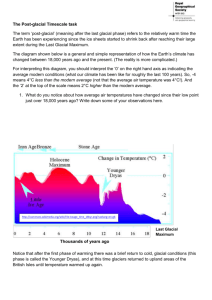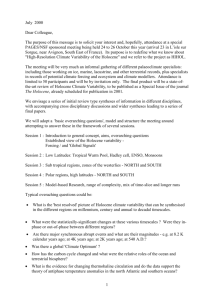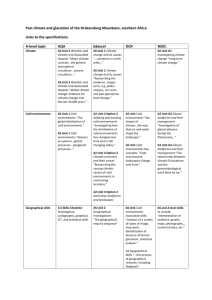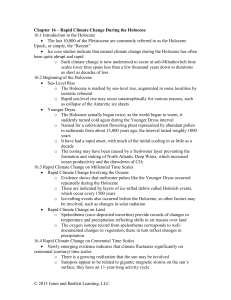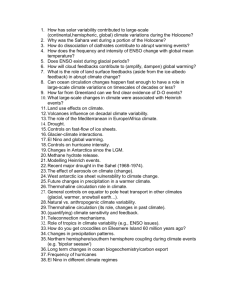Paleoclimatic data from 74KL and Guliya cores: New insights Govindan Rangarajan
advertisement
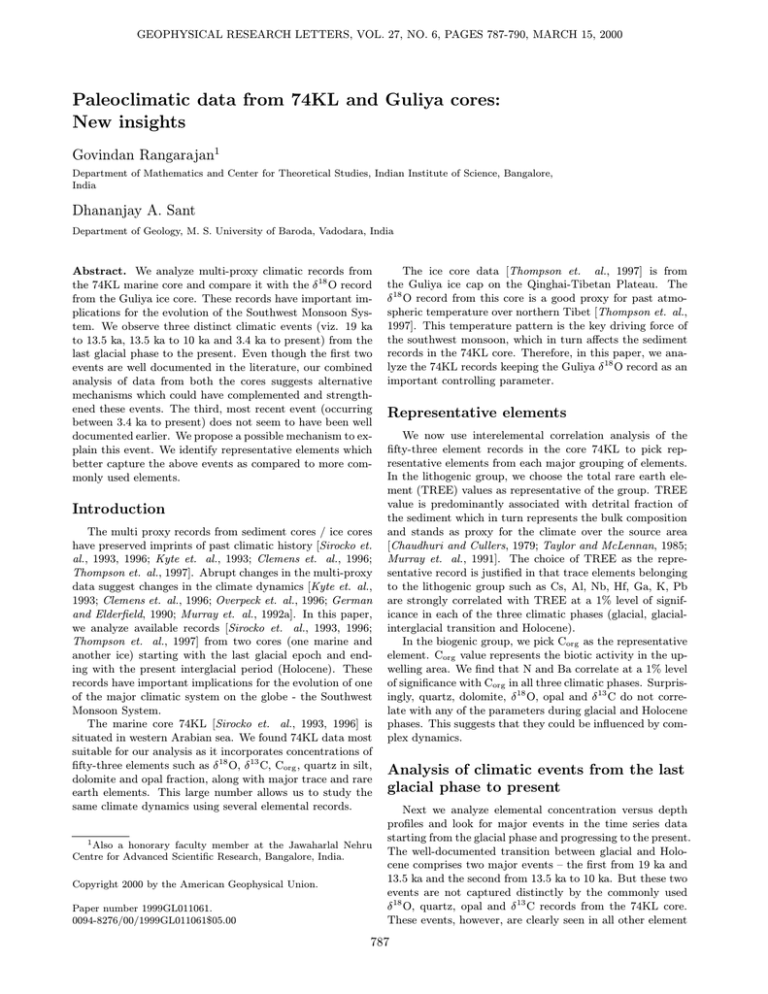
GEOPHYSICAL RESEARCH LETTERS, VOL. 27, NO. 6, PAGES 787-790, MARCH 15, 2000 Paleoclimatic data from 74KL and Guliya cores: New insights Govindan Rangarajan1 Department of Mathematics and Center for Theoretical Studies, Indian Institute of Science, Bangalore, India Dhananjay A. Sant Department of Geology, M. S. University of Baroda, Vadodara, India Abstract. We analyze multi-proxy climatic records from the 74KL marine core and compare it with the δ 18 O record from the Guliya ice core. These records have important implications for the evolution of the Southwest Monsoon System. We observe three distinct climatic events (viz. 19 ka to 13.5 ka, 13.5 ka to 10 ka and 3.4 ka to present) from the last glacial phase to the present. Even though the first two events are well documented in the literature, our combined analysis of data from both the cores suggests alternative mechanisms which could have complemented and strengthened these events. The third, most recent event (occurring between 3.4 ka to present) does not seem to have been well documented earlier. We propose a possible mechanism to explain this event. We identify representative elements which better capture the above events as compared to more commonly used elements. Introduction The multi proxy records from sediment cores / ice cores have preserved imprints of past climatic history [Sirocko et. al., 1993, 1996; Kyte et. al., 1993; Clemens et. al., 1996; Thompson et. al., 1997]. Abrupt changes in the multi-proxy data suggest changes in the climate dynamics [Kyte et. al., 1993; Clemens et. al., 1996; Overpeck et. al., 1996; German and Elderfield, 1990; Murray et. al., 1992a]. In this paper, we analyze available records [Sirocko et. al., 1993, 1996; Thompson et. al., 1997] from two cores (one marine and another ice) starting with the last glacial epoch and ending with the present interglacial period (Holocene). These records have important implications for the evolution of one of the major climatic system on the globe - the Southwest Monsoon System. The marine core 74KL [Sirocko et. al., 1993, 1996] is situated in western Arabian sea. We found 74KL data most suitable for our analysis as it incorporates concentrations of fifty-three elements such as δ 18 O, δ 13 C, Corg , quartz in silt, dolomite and opal fraction, along with major trace and rare earth elements. This large number allows us to study the same climate dynamics using several elemental records. 1 Also a honorary faculty member at the Jawaharlal Nehru Centre for Advanced Scientific Research, Bangalore, India. Copyright 2000 by the American Geophysical Union. Paper number 1999GL011061. 0094-8276/00/1999GL011061$05.00 The ice core data [Thompson et. al., 1997] is from the Guliya ice cap on the Qinghai-Tibetan Plateau. The δ 18 O record from this core is a good proxy for past atmospheric temperature over northern Tibet [Thompson et. al., 1997]. This temperature pattern is the key driving force of the southwest monsoon, which in turn affects the sediment records in the 74KL core. Therefore, in this paper, we analyze the 74KL records keeping the Guliya δ 18 O record as an important controlling parameter. Representative elements We now use interelemental correlation analysis of the fifty-three element records in the core 74KL to pick representative elements from each major grouping of elements. In the lithogenic group, we choose the total rare earth element (TREE) values as representative of the group. TREE value is predominantly associated with detrital fraction of the sediment which in turn represents the bulk composition and stands as proxy for the climate over the source area [Chaudhuri and Cullers, 1979; Taylor and McLennan, 1985; Murray et. al., 1991]. The choice of TREE as the representative record is justified in that trace elements belonging to the lithogenic group such as Cs, Al, Nb, Hf, Ga, K, Pb are strongly correlated with TREE at a 1% level of significance in each of the three climatic phases (glacial, glacialinterglacial transition and Holocene). In the biogenic group, we pick Corg as the representative element. Corg value represents the biotic activity in the upwelling area. We find that N and Ba correlate at a 1% level of significance with Corg in all three climatic phases. Surprisingly, quartz, dolomite, δ 18 O, opal and δ 13 C do not correlate with any of the parameters during glacial and Holocene phases. This suggests that they could be influenced by complex dynamics. Analysis of climatic events from the last glacial phase to present Next we analyze elemental concentration versus depth profiles and look for major events in the time series data starting from the glacial phase and progressing to the present. The well-documented transition between glacial and Holocene comprises two major events – the first from 19 ka and 13.5 ka and the second from 13.5 ka to 10 ka. But these two events are not captured distinctly by the commonly used δ 18 O, quartz, opal and δ 13 C records from the 74KL core. These events, however, are clearly seen in all other element 787 788 RANGARAJAN AND SANT: NEW INSIGHTS FROM PALEOCLIMATIC DATA 1.4 event 2 event 1 Corg 1.0 0.6 event 3 0.2 0 5 10 15 Age (ka) 20 25 The 74KL Corg record, a representative component from biogenic group. Data obtained from ftp://ftp.ngdc. noaa.gov, in the directory /paleo/paleocean/by contributor/ sirocko1993. Figure 1. records, which correlate well with the biogenic and lithogenic flux. cause the continent had undergone a long arid phase during glacial time whereby a large influx of eolian sediments would have already been blown into the sea. But during the deglaciation phase, we observe a sudden additional increase in the influx of sediments and a change in composition. This indicates that an additional process came into play at this time. This process could very well have been the high fluvial influx from the Himalayas that we have proposed above. The unstable conditions resulting from this large influx would also contribute to decrease in biotic activity and inorganic precipitation of carbonates and dolomite. From 16.5 ka to 13.5 ka (the second half of the first event), values for the biogenic group (Corg , N, Ba) increase by 139% on the average, those for trace elements decrease by 39% on the average and finally, values for rare earth elements decrease by 36% on the average. The accepted explanation [Sirocko et. al., 1993, 1996] for this change is the increase in southwest monsoon intensity leading to increased upwelling (and therefore increased biotic activity). From the Guliya δ 18 O record (Figure 3), we notice that δ 18 O has increased to its maximum value during this period indicating high temperatures over Tibet. This is consistent with the above explanation. First event (19 ka to 13.5 ka) Second event (13.5 ka to 10 ka) Next, we describe the second event, which lasted approximately between 13.5 ka and 10 ka. This event starts with a sharp decrease of 53% in the value of Corg , 40% drop in N and 19% drop in Ba values. On the other hand, trace and rare earth elements increase by an average of 20% and 13% respectively. The above observations can be explained as follows. A sharp decrease in the δ 18 O value starting at 13.5 ka has been previously observed [Thompson et. al., 1997] in the Guliya core data corresponding to the start of the Younger Dryas. This decrease is correlated to a corresponding decrease in temperature over Tibet resulting in weaker southwest monsoons and a more arid phase. These conditions lead to decreased biotic activity and increased lithogenic influx. The above event ends with an increase in biogenic components and a decrease in trace and rare earth components reversing the above trend. This has been well documented [Sirocko et. al., 1993, 1996]. 60 event 3 event 2 event 1 50 TREE We now analyze the first of the two events mentioned above in greater detail. Plots of representative element records from each major group viz. Corg for the biogenic group and TREE for the lithogenic group are given in Figures 1 and 2. From these figures, we observe a stable climatic regime in the late glacial period up to around 19 ka. The first event starts at the end of this period. The Corg , N and Ba values drop sharply up to 16.5 ka. The value drops by 73% for Corg (58% and 53% for N and Ba respectively) as compared to the mean value during the preceding stable regime. Values for trace and rare earth elements, however, increase by an average of 14% and 8% respectively. We now explain the above observations. An earlier work [Sirocko et. al., 1993, 1996] had interpreted the change in elemental values during this period as being caused by decrease in upwelling productivity and large eolian dust influx from an arid Arabia. We give below alternative mechanisms which could have complemented and strengthened the above mechanism. We now have available δ 18 O record from the Guliya core [see Figure 3]. This suggests that deglaciation was in full swing in the western Kunlun Shan during the above period as evidenced by a sharp increase in δ 18 O values. Thus, there was large-scale melting of ice sheets resulting in a sudden large-scale influx of water into the Arabian Sea. This would have contributed to the observed increase in trace and rare earth element values for reasons given below. As Himalayas is one of the youngest, active mountain chains, tectonic events would have lead to rapid mechanical breakdown of rocks thus exposing primary minerals for chemical weathering [Raymo et. al., 1988]. It is supposed that dissolved loads are highest in areas dominated by earlyeroded sedimentary rocks. Further, during glacial time (110 ka to 19 ka), sea levels were low and large continental areas were exposed [Fairbanks, 1989]. Therefore, rivers flowing from Himalayas during this time (in particular, Indus) must have flown further deep into Indian Ocean, affecting the sedimentation at 74KL site. Further, the eolian dust influx from Arabia could not have solely contributed to the sudden increase. This is be- 40 30 0 5 10 15 Age (ka) 20 25 Figure 2. The 74KL TREE record, a representative component from lithogenic group. Same source of data as in Figure 1. RANGARAJAN AND SANT: NEW INSIGHTS FROM PALEOCLIMATIC DATA -5 event 3 event 2 event 1 δ18O -10 -15 -20 -25 0 5 10 15 Age (ka) 20 25 Figure 3. The Guliya δ18 O record. Data obtained from Prof. L. G. Thompson. Third event (3.4 ka to present) Finally, we start our analysis of the Holocene period. During early and middle Holocene, the climate stabilized reflecting a moist phase. In this period, records of all elements show a stable phase with oscillations around mean value. Around 3.4 ka, we observe a significant change in most of the 74KL records other than δ 18 O, quartz, opal, δ 13 C and Cd records. We performed a statistical analysis to confirm the presence of this event by first dividing the Holocene into two periods – 10 ka to 3.4 ka (early and middle Holocene) and 3.4 ka to present (late Holocene). The mean values for these two periods were compared using the standard t-test (from statistics) for each of the records. For all records other than those listed above, a statistically significant change in the mean value (at the 1% level) was observed. To our knowledge, the above event has not been well documented in the literature. From the above statistical analysis, we find that the biogenic components (Corg , N and Ba) increased significantly during late Holocene by an average of 36%. Surprisingly, the lithogenic components (trace and rare earth elements) also increased significantly in this period (by an average of 20% and 27% respectively). This is a departure from the pattern observed during the transition period. We now give a possible explanation for the above observations. During the long, moist phase of early and middle Holocene, the continental rocks would have undergone deep weathering generating collouvium over the host rocks. From the Guliya δ 18 O record, we observe a general increase in δ 18 O value starting from 3.2 ka onwards. This corresponds to an increase in temperature over Tibet leading to melting of ice caps at higher altitudes. The snow melt could have easily carried the readily available collouvium downstream to Arabian sea leading to increase in values of trace and rare earth elements in the 74KL core sample. The Southwest monsoon precipitation would have added to this effect. Studies have shown dust flux is just 5% of the fluvial flux rate which is about 1.5 - 2.0 × 1016 gm / year [Hovan and Rea, 1992]. Hence, fluvial influx is a plausible mechanism for transport of trace and rare earth elements. To summarize, weathering took place during the early and middle Holocene whereas the actual erosion of the surface started around 3.2 ka. The steady inflow hypothesized above (as opposed to large scale deglaciation) would have also lead to an increase in upwelling and an increase in biogenic components. 789 On the other hand, using pollen data [Singh et. al., 1990] from lakes in Rajasthan, India, the late Holocene period has been inferred to be more arid as compared to the midHolocene period. Nevertheless, this does not imply aridity over the entire subcontinent (this inhomogeneity in precipitation pattern can be observed even in present day). This is supported by archeological evidences from Indus valley civilization (3100-1900 year B.C) which suggest numerous flood events [Rajaram, 1999; Radhakrishnan, 1999; Lambrick, 1967; Raikes, 1964; Dales, 1966]. According to them, local aridity in the Kutch - Rajasthan - Indus Plain region had compelled the population to migrate to the Indus valley. Further, it was the great Indus flood that played an important role in the decline of the Indus civilization. Moreover, records from bog, lake and fluvial sediments in the Spiti Valley in the Tethys Himalayas [Wake and Mayewski, 1995] and a record from Goa [Sarkar et. al., 1999] indicate moist phases in late Holocene. Hence, local factors can explain the apparent contradictions in climatic records from different sites. Further, inflow due to precipitation is hypothesized to constitute only a secondary, supplementing factor in the fluvial influx. Acknowledgments. Data on 74KL core was obtained from the National Geophysical Data Center data bank, ftp://ftp. ngdc.noaa.gov, in the directory /paleo/paleocean/by contributor/ sirocko1993. We thank Prof. L. G. Thompson for giving us the data from the Guliya ice core used in this paper and for his comments. We thank Prof. J. T. Overpeck for his comments. DAS was supported by Indian Institute of Science during his visit there when this work was carried out. References Chaudhuri, S. and R. L. Cullers, The distribution of rare earth elements in deeply buried Gulf coast sediments, Chem. Geol., 24, 327-338, 1979. Clemens, S. C., D. W. Murray, and W. L. Prell, Nonstationary phase of the Plio-Pleistocene Asian monsoon, Science, 274, 943-948, 1996. Dales, G. F., The decline of the Harappans, Scientific American, 241, 92-100, 1966. Fairbanks, R. G., A 17,000 years glacio-eustatic sea level record: influence of glacial melting rates on the younger Dryas event and deep ocean circulation, Nature, 342, 637-642, 1989. German, C. R. and H. Elderfield, Rare earth elements in NW Indian Ocean, Geochimica et Cosmochimica Acta, 54, 19291940 (1990). Hovan, S. A., and D. K. Rea, The Cenozoic record of continental mineral deposition on broken 90E ridge Indian Ocean: S. Africa aridity and sediment delivery from the Himalayas, Palaeooceonography, 7, 8333-8360, 1992. Kyte, F. T., M. Leinen, G. R. Heath, and L. Zhou, Cenozoic sedimentation history of the Central North Pacific: Inference from the elemental geochemistry of core LL44-GPC3, Geochimica et Cosmochimica Acta, 57, 1719-1740, 1993. Lambrick, H. T., The Indus flood plain and the “Indus Civilization”, Geographical Journal, 133, 483-495, 1967. Murray, R. W., et al., Rare earth, major and trace elements in chert from of the Franciscan Complex and Monterey Group, California: Assessing REE sources to fine-grained sediments, Geochimica et Cosmochimica Acta, 55, 1875-1895, 1991. Murray, R. W., et al., Interoceanic variation in the rare earth, major and trace element deposition chemistry of chert: Perspectives gained from the DSDP and ODP records, Geochimica et Cosmochimica Acta, 56, 1897-1913, 1992. Overpeck, J., D. Anderson, S. Trumbore, and W. Prell, The southwest Indian monsoon over the last 18000 years, Climate Dynamics, 12, 213-225, 1996. Radhakrishnan, B. P., Holocene chronology and Indian prehistory, Geol. Soc. Ind. Memoir, 42, xvii-xxv, 1999. 790 RANGARAJAN AND SANT: NEW INSIGHTS FROM PALEOCLIMATIC DATA Rajaram, N. S., Sarasvati civilization in the Harappan seals, Geol. Sco. Ind. Memoir, 42, 63-69, 1999. Raikes, R. L., The end of the ancient cities of the Indus, American Anthropologist, 66, 284-299, 1964. Raymo, M. E., W. F. Ruddiman, and P. N. Froelich, Influence of late Cenozoic mountain building on ocean geochemical cycles, Geology, 16, 649-653, 1988. Sarkar, A., R. Ramesh, B. L. K. Somayajulu, R. Agnihotri, A. J. T. Jull, and G. S. Burr, High resolution Holocene palaeomonsoon record from Eastern Arabian Sea, Earth and Planetary Science Letters, submitted, 1999. Singh, G., R. J. Wasson, and D. P. Aggarwal, Vegetational and seasonal climatic changes since the last full glacial in the Thar Desert, northwestern India, Review of Palaeobotany and Palynology, 64, 351-358, 1990. Sirocko, F., M. Sarnthein, H. Erienkeuser, H. Lange, M. Arnold, and J. C. Duplessy, Century-scale events in monsoonal climate over past 24,000 years, Nature, 354, 322-324, 1993. Sirocko, F., D. Grabe-Schonberg, A. McIntyre, and B. Molfino, Teleconnection between subtropical monsoon and highlatitude climates during the last glaciation, Science, 272, 526529, 1996. Taylor, S. R. and S. M. McLennan, The continental crust: Its composition and evolution, Blackwell, 1985. Thompson, L. G., T. Yao, M. E. Davis, K. A. Henderson, E. M. Thompson, P. -N. Lin, J. Beer, H. -A. Synal, J. Cole-Dai, and J. F. Bolzan, Tropical climate instability: The last glacial cycle from Qinghai-Tibetan ice core, Science, 276, 1821-1825, 1997. Wake, C. P. and P. A. Mayewski (Eds.), Summary of existing paleoclimatic records from the highlands of Central Asia, in Report on the International Himalayan/ Tibetan Plateau Paleoclimate Workshop, Kathmandu, 1995. G.Rangarajan, Department of Mathematics and Center for Theoretical Studies, Indian Institute of Science, Bangalore 560 012, India. (e-mail: rangaraj@math.iisc. ernet.in) D. A. Sant, Department of Geology, M. S. University of Baroda, Vadodara 390 002, India. (Received September 09, 1999; accepted January 20, 2000.)
